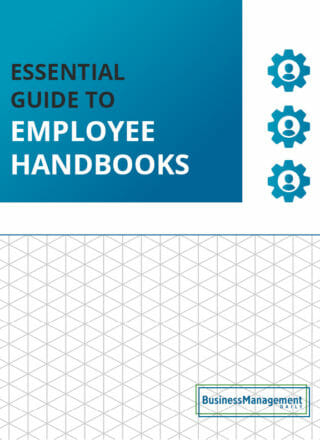Employer’s guide to written warnings for employee discipline
How to issue a written warning to an employee
Written warnings, or write-ups, are among the most well-known employee disciplinary procedures. While nobody likes giving or receiving a written warning, they do serve a purpose in enforcing company policies and creating a paper trail if an issue rises to the level of termination.
Written warnings serve two purposes; record-keeping and communication. So, you must include the right information to convey the problem. If you’re unsure what to include or when to issue a written warning, keep reading to learn how to navigate issuing a written warning.
What is a written warning?
Written warnings are a form of employee discipline used to correct poor performance or misconduct. They are letters describing the behavior issue at hand, the changes that need to be made, and a warning that further discipline may occur if corrective actions are not taken to improve performance or behavior.
Written warnings can be used to address a variety of issues, such as:
-
Frequent tardiness
-
Excessive absenteeism
-
Poor work performance
-
Dress code violations
-
Behavioral problems like poor attitude or inappropriate workplace conduct.
-
Disregarding safety procedures
-
Failing to meet deadlines
-
Insubordination
-
Violations of the employee code of conduct
The goal of a written warning should be to encourage the employee to improve and to guide them along that journey. Unfortunately, that improvement does not always occur, so these warnings act as documentation to help protect employers if an employee is terminated.
Having signed, written letters showing that the employee had received proper coaching and prior warnings before being terminated for a performance or conduct issue may help employers dispute claims such as wrongful termination.
What to include in a written warning
Written warnings are comprehensive documents that describe performance and conduct issues. When creating a written warning, make sure you include the information below.
Details of the employee’s behavior
The written warning letter should clearly list the details of any infractions or performance issues. Whenever possible, cite specific incidents with dates and relevant details.
For example, when writing up an employee for attendance, you should be able to list out any instances of tardiness or excessive absenteeism with dates and times.
Give a clear picture of the issue and show how their behavior impacts the company, customers, or team.
An explanation of the violated company policy or unmet expectations
Point to the specific company policy that was violated, or explain the performance expectation the employee fails to meet. If applicable, you should provide a copy of the company policy or point the employee to its location within the employee handbook.
An employee might receive a formal written warning for poor performance. In this case, you should cite relevant documentation. This documentation could include past performance reviews.
Specifically, it should be those where you discussed the issue. You can also include previously established performance metrics or quotas.
Furthermore, guidelines related to work quality should be added to support the write-up. Employees should generally know what is expected of them and have received prior coaching before being given a written warning for performance.
Clear instructions regarding future conduct
Tell employees what you want them to do moving forward. This can be a quick sentence or two telling them they must arrive on time each day or comply with the dress code.
It may also include more detailed performance improvement steps and quantitative measures of success (such as hitting a specific sales goal or productivity metric). Be sure to note any other follow-up steps, such as more frequent performance check-ins or added training, that need to be completed to support their improvement.
Potential consequences if performance is not improved
Tell the employee what will happen if they don’t heed your first written warning. Often, employers leave this a bit open-ended with statements like; “further disciplinary action, up to and including termination, may be taken if additional infractions occur”.
This leaves room for managers or HR professionals to utilize additional warnings, suspensions, performance improvement plans, or termination based on the severity of the continued offenses.
How long the warning will be in effect
Written warnings often come with a probationary period or remain on the employee’s record for a certain period. Warnings should usually remain on file for 6-12 months. Additional infractions during that period will lead to a second written warning or other progressive discipline.
If no further policy violations occur in the employee warning notice period, the employee can start fresh with a clean disciplinary record. This incentivizes them to improve promptly and ensures that a written warning isn’t looming over an employee indefinitely.
When to issue a written warning
Find out whether it’s time to write up an employee or if you should hold off and try a lesser form of discipline.
When the employee has failed to improve after a verbal warning
Employees can use different types of warnings to address performance issues or policy infractions. The first step in the disciplinary process is typically a verbal warning. It typically covers information similar to that of a written warning. This includes an overview of the employee’s actions.
Additionally, it includes a warning that further disciplinary action may occur. This will happen if the employee does not improve their behavior or performance.
Suppose an employee has already received a verbal warning and continues to violate the same company policy or demonstrates an ongoing performance issue. In that case, it’s time to move on to a written warning.
When a major policy violation has occurred
Progressive discipline is ideal in most cases. However, sometimes a severe policy violation occurs. In these instances, you must skip to a formal written warning on the first offense. This often applies to policies regarding workplace safety, harassment, or discrimination.
In these cases, employees need to have a lower tolerance for misconduct. This lower tolerance helps maintain a safe work environment.
In particularly egregious instances, employers may skip the written warning and move on to immediate termination. However, you may want to seek legal advice when firing an employee without a prior discipline history.
Frequently asked questions about written warnings
Still have questions about written warnings? Check out the FAQs below.
Do you have to give a verbal warning before a written warning?
Most employers use a progressive discipline approach that starts with a verbal warning and then escalates to a written warning if improvement is not made. However, there is no legal requirement to give a verbal warning before a written warning.
Employers often skip the verbal warning in cases of more serious misconduct that may harm the business or other employees. This may include disregarding important safety procedures, harassment, or behaving in a manner that harms the business’ reputation with customers.
Can employees receive multiple written warnings for the same issue?
Yes, it’s not uncommon for employees to receive multiple warnings for the same infraction if improvement isn’t made following the first written warning. The second or third written warning is often considered the final one and will lead to suspension or termination of employment.
To treat employees fairly and consistently, it’s best to have a standardized disciplinary policy regarding final warnings. Decide how many warnings employees can incur before getting a final warning and what the timeframe is.
A common policy is that employees may be terminated if they incur three written warnings within a set time period.
Who should be present when issuing a written warning?
Supervisors or managers typically want a witness present at the disciplinary hearing, where a written warning will be given. Most commonly, an HR representative will be invited to the meeting. A union representative may also be present for union-covered employees.
Avoid having other parties, such as co-workers, present or within earshot. Receiving a written warning is a stressful experience, so be respectful of the employee by delivering the warning in a private area, such as a meeting room or a private office in the HR department. If you have an open office layout, avoid giving warnings at the employee’s desk.
Who gets a copy of the written warning?
The employee should be given a written copy of the warning letter to read and sign. The supervisor or a human resources team member will also sign the document. The employee should be provided a copy for their records, and another copy should be stored in their personnel file.
Can employees appeal written warnings?
If an employee wants to dispute the warning, some form of appeal procedure should be in place. This often requires the employee to submit a rebuttal letter to the HR department with evidence or an explanation of the matter.
Appeals should be rare if you research and investigate adequately before writing up an employee. You should have your facts straight. Additionally, you should cite specific evidence or examples. This evidence should support the warning.
Furthermore, you should give the employee a prior verbal warning. Then, there shouldn’t be much disagreement, as the employee will likely have seen the warning coming.
More resources:
Written warning template for employee discipline ![]()
Workplace etiquette: The ultimate guide to professionalism ![]()
90 sample phrases for negative performance reviews ![]()






